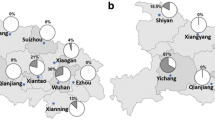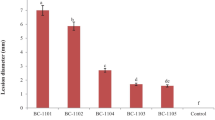Abstract
Thiabendazole and thiophanate-methyl (methyl benzimidazole carbamate group — MBC) are fungicides commonly used in mango orchards in the Brazilian Northeast, although they are not registered to control dieback and stem-end rot. However, populations of Botryosphaeriaceae are exposed to these fungicides, and resistance may evolve. Therefore, the sensitivity of 154 Botryosphaeriaceae isolates was evaluated by analyzing the effective concentration required to inhibit 50% of mycelial growth (EC50). Ten isolates with the lowest (sensitive—S) and highest (less sensitive—LS) EC50 values for thiabendazole and thiophanate-methyl were evaluated for the stability of the sensitivity, the molecular mechanisms behind low sensitivity, the effectiveness of MBCs to control disease in mango fruits and the components of fitness. Isolates exhibited EC50 values ranging from 0.03 to 6.86 μg ml−1 and from 0.0001 to 10.70 μg ml−1 for thiabendazole and thiophanate-methyl, respectively. A significant and positive correlation (P ≤ 0.01; r = 0.82) was detected between the sensitivity of the isolates to both fungicides. The LS isolates were able to maintain this characteristic after 10 generations and did not have reduced fitness compared with the S isolates. Nevertheless, the most common mutation associated with a low sensitivity to MBCs (at codon 198 of the β-tubulin gene) was not found. Both fungicides were able to control the infection caused by S and LS isolates similarly. Thus, thiabendazole and thiophanate-methyl can be used to control dieback and stem-end rot in mango orchards in the Brazilian Northeast.




Similar content being viewed by others

References
Albertini, C., Gredt, M., & Leroux, P. (1999). Mutations of the β-tubulin gene associated with different phenotypes of benzimidazole resistance in the cereal eyespot fungi Tapesia yallundae and Tapesia acuformis. Pesticide Biochemistry Physiology, 64, 17–31.
Amponsah, N. T., Jones, E., Ridgway, H. J., & Jaspers, M. V. (2012). Evaluation of fungicides for the management of Botryosphaeria dieback diseases of grapevines. Pest Management Science, 68, 676–683.
Avenot, H. F., & Michailides, T. J. (2010). Progress in understanding molecular mechanisms and evolution of resistance to succinate dehydrogenase inhibiting (SDHI) fungicides in phytopathogenic fungi. Crop Protection, 29, 643–651.
Baraldi, E., Mari, M., Chierici, E., Pondrelli, E., Bertolini, P., & Pratella, G. C. (2003). Studies on thiabendazole resistance of Penicillium expansum of pears: Pathogenic fitness and genetic characterization. Plant Pathology, 52, 362–370.
Brent, K. J., & Hollomon, D. W. (2007). Fungicide resistance in crop pathogens: How can it be managed? Brussels: Fungicide Resistance Action Committee.
Cavalcante, R. D., Lima, W. G., Martins, R. B., Tovar-Pedraza, J. M., Michereff, S. J., & Câmara, M. P. S. (2014). Thiophanate-methyl sensitivity and fitness in Lasiodiplodia theobromae populations from papaya in Brazil. European Journal of Plant Pathology, 140, 251–259.
Chen, S. N., Shang, Y., Wang, Y., Schnabel, G., Lin, Y., Yin, L. F., & Luo, C. X. (2014). Sensitivity of Monilinia fructicola from peach farms in China to four fungicides and characterization of isolates resistant to carbendazim and azoxystrobin. Plant Disease, 98, 1555–1560.
Cooley, R. N., & Caten, C. E. (1993). Molecular analyses of the Septoria nodorum β-tubulin gene and characterization of a benomyl-resistance mutation. Molecular Genetics and Genomics, 237, 58–64.
Costa, V. S. O., Michereff, S. J., Martins, R. B., Gava, C. A. T., Mizubuti, E. S. G., & Câmara, M. P. S. (2010). Species of Botryosphaeriaceae associated on mango in Brazil. European Journal of Plant Pathology, 127, 509–519.
Cunha, M. G., & Rizzo, D. M. (2003). Development of fungicide cross resistance in Helminthosporium solani populations from California. Plant Disease, 87, 798–803.
Davidson, R. M., Hanson, L. E., Franc, G. D., & Panella, L. (2006). Analysis of β-tubulin gene fragments from benzimidazole-sensitive and -tolerant Cercospora beticola. Journal of Phytopathology, 154, 321–328.
FAO. (2017). Resource database. http://faostat3.fao.org/home/E. Accessed on 06 January 2016.Accessed on 30 January 2017.
FRAC. (2016). Benzimidazoles: resistance risk and current status. Resource document. http://www.frac.info/expertfora/benzimidazoles/resistance-risk-and-current-status. Accessed on 30 January 2017.
Fujimura, M., Banno, S., Ichiishi, A., & Fukumori, F. (2015). Histidine kinase inhibitors. In H. Ishii & D. W. Hollomon (Eds.), Fungicide resistance in plant pathogens: Principles and a guide to practical management (pp. 181–197). Tokyo: Springer Japan.
Hou, Y., Lou, Q., Chen, C., & Zou, M. (2011). Application of cycleave PCR to the detection of a 28 point mutation (F167Y) in the β2-tubulin gene of Fusarium graminearum. Pest Management Science, 67, 1124–1128.
Ishii, H. (2015). Stability of resistance. In H. Ishii & D. W. Hollomon (Eds.), Fungicide resistance in plant pathogens: Principles and a guide to practical management (pp. 35–48). Tokyo: Springer Japan.
Koenraadt, H., Somerville, S. C., & Jones, L. (1992). Characterization of mutations in the beta-tubulin gene of benomyl-resistant field strains of Venturia inaequalis and other plant pathogenic fungi. Phytopathology, 82, 1348–1354.
Kongtragoul, P., Nalumpang, S., & Miyamoto, Y. (2011). Mutation at codon 198 of Tub2 gene for carbendazim resistance in Colletotrichum gloeosporioides causing mango anthracnose in Thailand. Journal of Plant Protection Research, 51, 378–384.
Lee, M. H., Pan, S., Ng, T., Chen, P., Wang, L., & Chung, K. (2011). Mutations of β-tubulin codon 198 or 200 indicate thiabendazole resistance among isolates of Penicillium digitatum collected from citrus in Taiwan. International Journal of Food Microbiology, 150, 157–163.
Leroux, P., Gredt, M., Walker, A. S., Moinard, J. M., & Caron, D. (2005). Resistance of the wheat leaf blotch pathogen Septoria triticiti fungicides in France. In H. W. Dehne, H. B. Deising, U. Gisi, K. H. Kuck, P. E. Russell, & H. Lyr (Eds.), Modern fungicides and antifungal compounds IV (pp. 115–124). Alton: The British Crop Protection Council.
Luck, J. E., & Gillings, M. R. (1995). Rapid identification of benomyl resistant strains of Botrytis cinerea using the polymerase chain reaction. Mycological Research, 99, 1483–1488.
Luque, J., Pera, J., & Parlade, J. (2008). Evaluation of fungicides for the control of Botryosphaeria corticola on cork oak in Catalonia (NE Spain). Forest Pathology, 38, 147–155.
Ma, Z., & Michailides, T. J. (2005). Advances in understanding molecular mechanisms of fungicide resistance and molecular detection of resistant genotypes in phytopathogenic fungi. Crop Protection, 24, 853–863.
Ma, Z., Yoshimura, M. A., Holtz, B. A., & Michailides, T. J. (2005). Characterization and PCR-based detection of benzimidazole-resistant isolates of Monilinia laxa in California. Pest Management Science, 61, 449–452.
MAPA. (2017). Agrofit - Sistema de agrotóxicos fitossanitários. Resource database. http://extranet.agricultura.gov.br/agrofit_cons/principal_agrofit_cons. Accessed on 30 January 2017.
Marques, M. W., Lima, N. B., Michereff, S. J., Câmara, M. P. S., & Souza, C. R. B. (2012). First report of mango dieback caused by Pseudofusicoccum stromaticum in Brazil. Plant Disease, 96, 144–145.
Marques, M. W., Lima, N. B., Morais Junior, M. A., Barbosa, M. A. G., Souza, B. O., Michereff, S. J., Phillips, A. J. L., & Câmara, M. P. S. (2013a). Species of Lasiodiplodia associated with mango in Brazil. Fungal Diversity, 61, 181–193.
Marques, M. W., Lima, N. B., Morais Junior, M. A., Michereff, S. J., Phillips, A. J. L., & Câmara, M. P. S. (2013b). Botryosphaeria, Neofusicoccum, Neoscytalidium and Pseudofusicoccum species associated with mango in Brazil. Fungal Diversity, 61, 195–208.
Mckay, G. J., Egan, D., Morris, E., & Brown, A. E. (1998). Identifiaction of benzimidazole resistance in Cladobotryum dendroides using a PCR-based method. Mycological Research, 102, 671–676.
Miin-Huey, L., Shiah-Mei, P., Tieng-Wui, N. G., Po-Sheng, C., Li-Yuan, W., & Kuang-Ren, C. (2011). Mutations of β-tubulin codon 198 or 200 indicate thiabendazole resistance among isolates of Penicillium digitatum collected from citrus in Taiwan. International Journal of Food Microbiology, 150, 157–163.
Ministério da Agricultura, Pecuária e Abastecimento. (2012). Regulamento técnico da manga.http://sistemasweb.agricultura.gov.br/sislegis/action/detalhaAto.do?method=visualizarAtoPortalMapa&chave=1754709875. Accessed on 30 January 2017.
Pereira, A. V. S., Martins, R. B., Michereff, S. J., Silva, M. B., & Câmara, M. P. S. (2012). Sensitivity of Lasiodiplodia theobromae from Brazilian papaya orchards to MBC and DMI fungicides. European Journal of Plant Pathology, 132, 489–498.
Pitt, W. M., Sosnowski, M. R., Huang, R., Qiu, Y., Steel, C. C., & Savocchia, S. (2012). Evaluation of fungicides for the management of Botryosphaeria canker of grapevines. Plant Disease, 96, 1303–1308.
Ploetz, R. C. (2003). Diseases of mango. In R. C. Ploetz (Ed.), Diseases of tropical fruit crops (pp. 327–363). Wallingford: CAB International.
Prusky, D., Kobiler, I., Miyara, I., & Alkan, N. (2009). Fruit diseases. In R. E. Litz (Ed.), The mango: botany, production and uses (pp. 210–230). Wallingford: CAB International.
Santos Filho, H. P., & Matos, A. P (2000). Doenças e seu controle. In A. P. Matos (Ed.), Manga produção: aspectos técnicos. (pp. 50–54). Brasília: Embrapa Comunicação para Transferência de Tecnologia.
Serrano, M. S., Romero, M. A., Jiménez, J. J., Vita, P., Avila, A., Trapero, A., & Sánchez, M. E. (2015). Preventive control Botryosphaeria canker affecting Quercus suber in southern Spain. Forestry, 88, 500–507.
Shi, H., Wu, H., Zhang, C., & Shen, X. (2013). Monitoring and characterization of resistance development of strawberry Phomopsis leaf blight to fungicides. European Journal of Plant Pathology, 135, 655–660.
Sierotzki, H. (2015). Respiration inhibitors: complex III. In H. Ishii & D. W. Hollomon (Eds.), Fungicide resistance in plant pathogens (pp. 119–144). Tokyo: Springer Japan.
Slippers, B., Johnson, G. I., Crous, P. W., Coutinho, T. A., Wingfield, B., & Wingfield, M. J. (2005). Phylogenetic and morphological reevaluation of the Botryosphaeria species causing diseases of Mangifera indica. Mycologia, 97, 99–110.
Terao, D., Batista, D. C., & Ribeiro, I. J. A. (2016). Doenças da mangueira. In H. Himati, L. Amorim, J. A. M. Rezende, A. Bergamin Filho, & L. E. A. Camargo (Eds.), Manual de Fitopatologia: Doenças de Plantas Cultivadas (pp. 523–533). Ouro Fino: Agronômica Ceres.
Treichel, M., Kist, B. B., Santos, C. E., Carvalho, C., & Beling, R. R. (2016). Anuário Brasileiro da Fruticultura. Editora Gazeta: Santa Cruz do Sul.
Tsuji, S. S. (2016). Mecanismos de resistência de Lasiodiploidia theobromae a fungicidas. Tese (Doutorado em Fitopatologia) - Universidade Federal Rural de Pernambuco.
Vega, B., & Dewdney, M. M. (2014). QoI-resistance stability in relation to pathogenic and saprophytic fitness components of Alternaria alternate from citrus. Phytopathology, 98, 1371–1378.
Walker, A. S., Micoud, A., Rémuson, F., Grosman, J., Gredt, M., & Leroux, P. (2013). French vineyards provide information that opens ways for effective resistance management of Botrytis cinerea (grey mould). Pest Management Science, 69, 667–678.
Yahia, E. M. (2011). Mango (Mangifera indica L.). In E. M. Yahia (Ed.), Postharvest biology and technology of tropical and subtropical fruits: Cocona to mango (pp. 492–565). Cambridge: Woodhead Publishing.
Young, D. H. (2015). Anti-tubulin agents. In H. Ishii & D. W. Hollomon (Eds.), Fungicide resistance in plant pathogens: principles and a guide to practical management (pp. 93–104). Springer Japan: Tokyo.
Zhang, L., Jia, X., Chen, C., & Zhou, M. (2013). Characterization of carbendazim sensitivity and trichothecene chemotypes of Fusarium graminearum in Jiangsu Province of China. Physiological and Molecular Plant Pathology, 84, 53–60.
Acknowledgements
The first author thanks the Conselho Nacional de Desenvolvimento Científico e Tecnológico – CNPq for a master scholarship and S. J. Michereff and M. P. S. Câmara are thankful for their research fellowship.
Author information
Authors and Affiliations
Corresponding author
Ethics declarations
All principles of ethical and professional conduct have been followed during this research and elaboration of this manuscript.
Conflict of interest
The authors declare that they have no conflict of interest.
Research involving human participants and/or animals
Not applicable.
Informed consent
Not applicable.
Rights and permissions
About this article
Cite this article
dos Santos, K.M., Tsuji, S.S., Câmara, M.P.S. et al. Sensitivity to methyl benzimidazole carbamate fungicides of Botryosphaeriaceae species from mango orchards in the Northeast of Brazil. Eur J Plant Pathol 153, 209–222 (2019). https://doi.org/10.1007/s10658-018-1556-y
Accepted:
Published:
Issue Date:
DOI: https://doi.org/10.1007/s10658-018-1556-y



